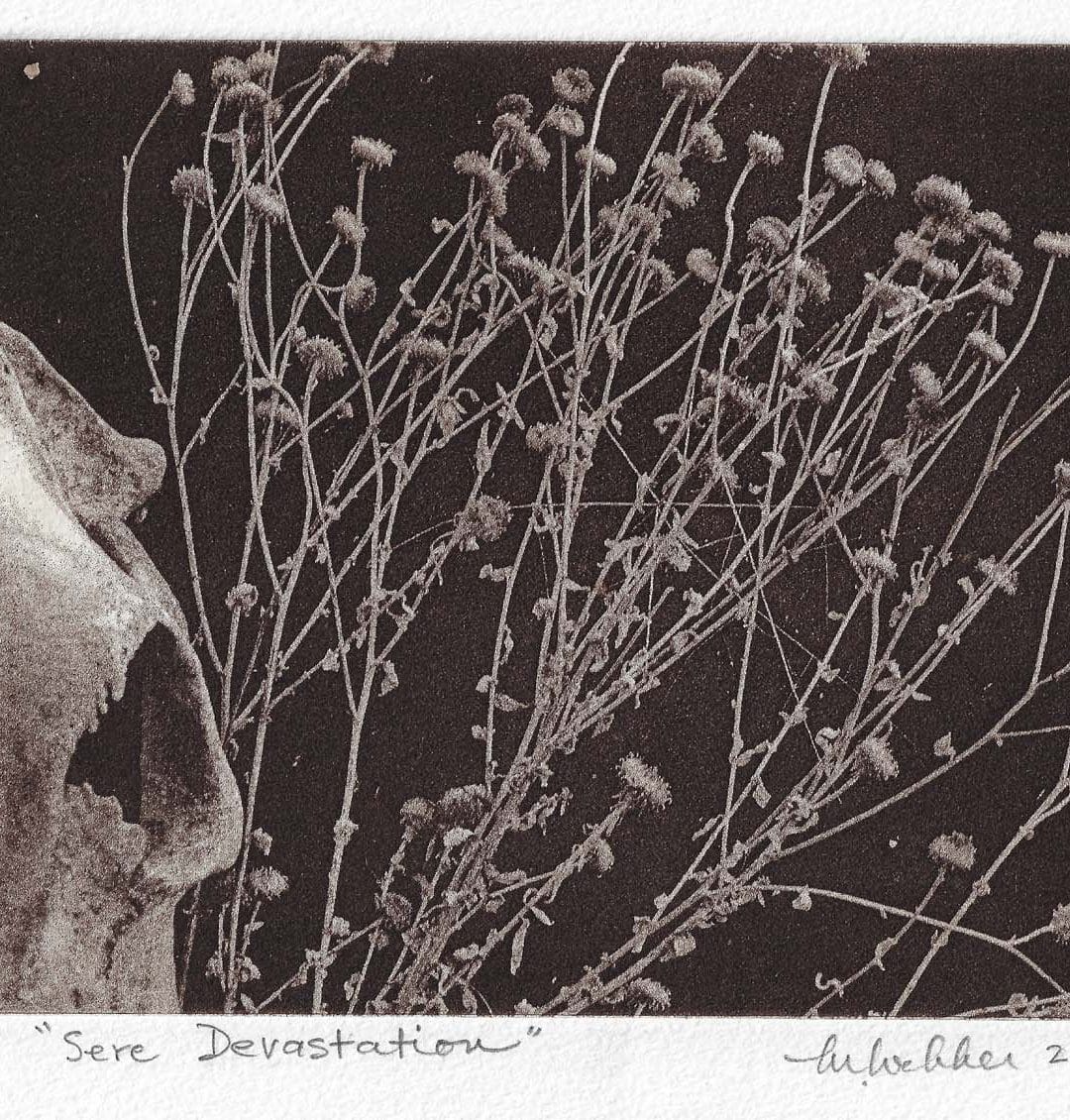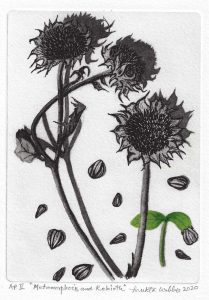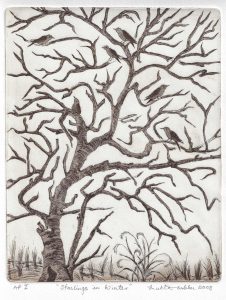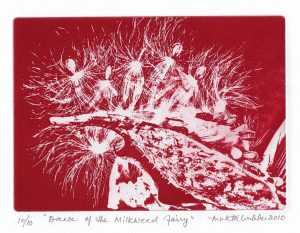(I envisioned Endangered as an exhibition about our disconnection from nature and the inevitable tragic outcome, a continuation of Seton’s warnings. The invited artists created a variety of responses. Intended for the walls of the Seton Gallery, the show is presented in a series of website postings. Images and text copyright belong to the individual artists. dlw)
Text by Mukta M. Webber
Ernest Thomson Seton’s powerful “Lament”, written almost a century ago, recorded his horror at the growing devastation of wildlife, forests, and habitat. He saw that the cause was humankind’s greed, lack of foresight, and caring for nature. It saw gloom and doom and, regrettably, this path of destruction continues.
Seton left a legacy of creativity through his art, writings, and teachings. He believed that we can change, that evils of our society could be banished, and that Nature is resilient.
My series a prints are arranged from death and desolation to one of rebirth and recovery to dancing for joy. The prints reflect my personal optimism that when mankind reverses its assault on our planet that the Earth System will recover. In the present environment, we need a message of survival, hope, and joy.
“Sere Devastation”
About the Lead Image: Can you see the Norwegian Artist Edvard Munch’s “Scream” on the cow skull? Such devastation, while sere and apparently hopeless, reminds us that there can be recovery and that life can return from shattered happenings. This image and inspiration was gathered from the edge the Bosque.
Bosque del Apache is a National Wildlife Refuge along the Rio Grande south of Socorro, New Mexico. Bosque, Spanish for “woods”, refers to forest along river flood planes in southwestern United States. Native people camped at this riverside “Woods of the Apache”. The extraordinary diversity of plants in this green oasis amidst arid land provides seeds and shelter for resident and wintering birds.
Among the most spectacular National Wildlife Refuges in North America, the Bosque provides habitat and refuge for migratory birds and endangered species. Preservation of such wintering and migratory stopover sites is vital to the survival of many bird species. Fall migration is an exciting time at the Bosque. Return is a compelling theme when tens of thousands of snow geese, sandhill cranes, and other waterfowl gather each autumn to spend the winter, feed and rest, before returning to their breeding grounds in Alaska and Canada. For bald eagle, great blue heron, pheasant, quail, roadrunners, and many songbirds, the underbrush of daisies and grasses is a year-round refuge. At dusk, flocks of birds astound human visitors, as they erupt in an explosion of wings, trumpet calls of sandhill cranes and honking of snow geese, when they lift off from their feeding grounds to return to the night time safety of marshes and ponds.
Captivated by the variety of flowers and wildlife and the beauty of marshes, waterways, and surrounding hills, visitors return to the Bosque time and time again.
“Waiting for Rebirth”
About the Image: Daisy remnants, at the side of the Bosque, form an intricate tangle of dry straw and flower heads, testament to a summer beauty and promise of their return as delicate flowers that will be a source of nectar for butterflies and seeds for songbirds.
Bosque del Apache is a National Wildlife Refuge along the Rio Grande south of Socorro, New Mexico. Bosque, Spanish for “woods”, refers to forest along river flood planes in southwestern United States. Native people camped at this riverside “Woods of the Apache”. The extraordinary diversity of plants in this green oasis amidst arid land provides seeds and shelter for resident and wintering birds.
Among the most spectacular National Wildlife Refuges in North America, the Bosque provides habitat and refuge for migratory birds and endangered species. Preservation of such wintering and migratory stopover sites is vital to the survival of many bird species. Fall migration is an exciting time at the Bosque. Return is a compelling theme when tens of thousands of snow geese, sandhill cranes, and other waterfowl gather each autumn to spend the winter, feed and rest, before returning to their breeding grounds in Alaska and Canada. For bald eagle, great blue heron, pheasant, quail, roadrunners, and many songbirds, the underbrush of daisies and grasses is a year-round refuge. At dusk, flocks of birds astound human visitors, as they erupt in an explosion of wings, trumpet calls of sandhill cranes and honking of snow geese, when they lift off from their feeding grounds to return to the night time safety of marshes and ponds.
Captivated by the variety of flowers and wildlife and the beauty of marshes, waterways, and surrounding hills, visitors return to the Bosque time and time again.
“Metamorphosis and Rebirth”
About the image: This image shows mature sunflowers, seeds, and a young seedling with its two cotyledons or seed leaves. It is symbolic of the cycle of life.
Sunflower – Helianthus annuus:
This is the wild sunflower, native to Central and North America. It was grown by Native people for seeds, as food, nearly 3,000 years ago. Domesticated varieties, with a single large flower, are grown throughout the world as a food and oil producing crop. The ancestral native plants depicted here have many small flowers and are common along our roadsides.
Each sunflower is a disk of several hundred small, single-seeded flowers. Flowers are arranged on the disk as a spiral flowing from its center. The flowers with the yellow petals are “ray flowers” attracting insects for nectar produced by all flowers, leaves, and stems. Birds and mammals feed on the seeds. Oil from seeds is used for cooking and to make diesel fuel. The remainder is used for livestock and poultry.
Sunflowers belong to a large family called the Asteraceae. Young flowers are “sun seekers” or “heliotropic”; they follow the sun from east to west. Sunflowers have been a favorite subject of famous artists, such as, Van Gogh and Georgia O’Keefe and are now used as a symbol of “green energy”.
“Starlings in Winter”
Looking forward to Spring.
The common or European starling is native to most of temperate Europe and western Asia. It was brought to N. America around 1890 and it soon spread across the continent. Their ability to adapt to a variety of habitats, including those modified by humans, has allowed them to spread throughout the world.
Adult starlings have iridescent feathers with hues of green, bronze, blue, and purple, which become spangled with white in fall and winter. They have a short tail, they walk rather than hop, and have a sharp dark bill which turns yellow in the spring during the breeding season. They have a wide variety of melodic songs and can mimic songs of other birds. Starlings are omnivorous, eating insects, seeds, and berries. Unpaired males begin to build a nest, decorating it with flowers and fresh greens to attract a female. Nests are lined with feathers and soft leaves. Fresh herbs are added to the nest as insect repellents. The female lays 4 to 5 small, glossy, pale turquoise blue eggs that hatch in about 13 days.
In autumn and winter, before roosting for the night, they gather in spectacular flocks called a “murmuration”. This is a sure sign that winter is coming. In early morning and evening they gather in trees murmuring and whistling amongst themselves. At dusk the flocks may be seen flying in synchronized waves making a whooshing sound that can be heard from far away. The flocks expand and contract, frequently changing shape, a most dazzling display of nature, a ballet in the sky. Huge flocks of more than a million starlings have been seen before sunset in southwestern Denmark.
“Dance of the Milkweed Fairy”
About the image: A milkweed seed pod is depicted with emerging, silky, floss-tufted seeds. There is joy at the thought of rebirth.
Milkweed – Asclepias syriaca:
Common milkweed also known as Butterfly flower or silkweed, is native to North America. In New Mexico, we see it growing along the roadside. Large seed pods release seeds with long flossy hairs which help them float great distances even on a light breeze.
A very effective sunscreen can be extracted from the seed’s oil. Seed floss and fiber from stems have been used by Native Americans to make fabric and rope, and nectar from flowers as a sweetener. Floss from commercially grown milkweed is used as a filling for pillows. The plant derives its name from its milky latex sap which can be used to make rubber. Monarch butterfly caterpillars feed only on milkweed leaves, hence, it is grown in gardens to attract butterflies.
The latex contains toxic glycosides which are heart poisons making the plant toxic to sheep and other animals. Contact with milkweed may cause allergic dermatitis in some people. Monarch butterfly caterpillars and butterflies accumulate the toxins in their tissues and birds learn to avoid them.





